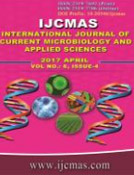


 National Academy of Agricultural Sciences (NAAS)
National Academy of Agricultural Sciences (NAAS)

|
PRINT ISSN : 2319-7692
Online ISSN : 2319-7706 Issues : 12 per year Publisher : Excellent Publishers Email : editorijcmas@gmail.com / submit@ijcmas.com Editor-in-chief: Dr.M.Prakash Index Copernicus ICV 2018: 95.39 NAAS RATING 2020: 5.38 |
An experiment was conducted at Punjab Agricultural University, Ludhiana to find out the appropriate planting method and optimum nitrogen level for enhancing the seed yield of fodder maize (Zea mays L.) variety J-1006. The experiment was conducted in strip plot design with three sowing methods viz. zero tillage (ZT), conventional tillage (CT) and bed planting (BP) in vertical strips and four nitrogen levels (0, 100, 125 and 150 kg N/ha) in horizontal strips. Pheonological parameters like days taken to 50% tasseling, days taken to 50% silking and days taken to physiological maturity were statistically at par with different planting methods except days taken to dough stage. Growth indices viz., Crop growth rate and Relative growth rate were significantly affected with planting methods except Net Assimilation Rate. Nitrogen application of 150 kg N/ha produced the significantly higher seed yield than 0, 100 and 125 kg N/ha. This was due to the higher number of cobs (1.2), cob girth (3.6), number of grains per cob (274.8) which were comparably higher in bed planted crop with 150 kg N/ha as compared to other treatments. Quality parameters viz., nitrogen content in grains and stover and protein content in grains were not significantly affected with different planting but bed planted crop showed increased content of nitrogen in grains (1.6%) and stover (1.4%) and protein content in grains (10%) as compared to zero tillage and conventional tillage methods. Different nitrogen levels showed increased nitrogen content in grains (1.8%), nitrogen content in stover (1.7%) and protein content in grains (11%) at 5 % significance level.
 |
 |
 |
 |
 |